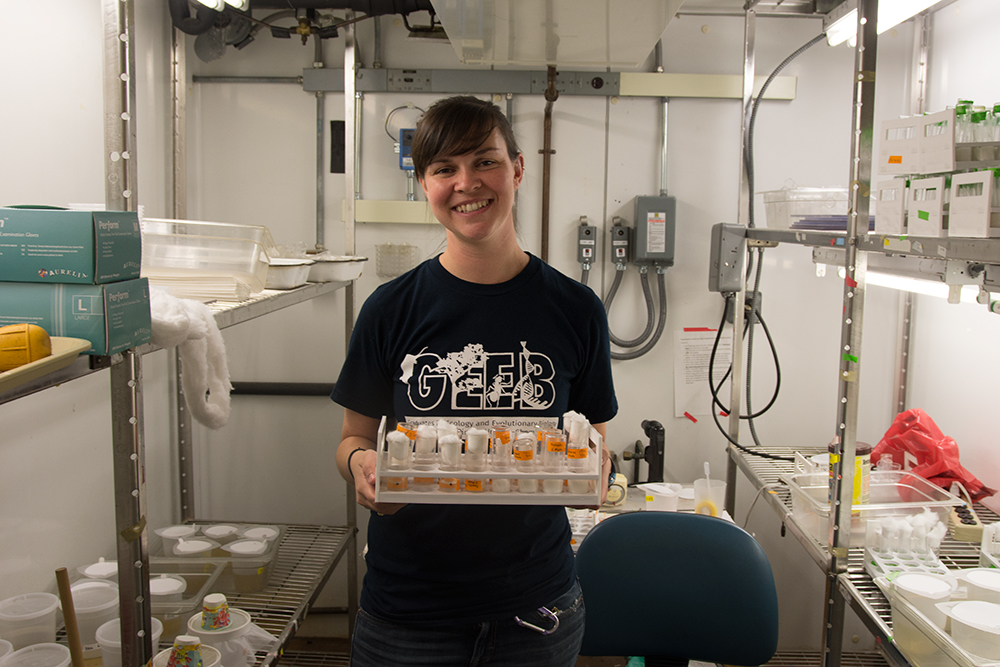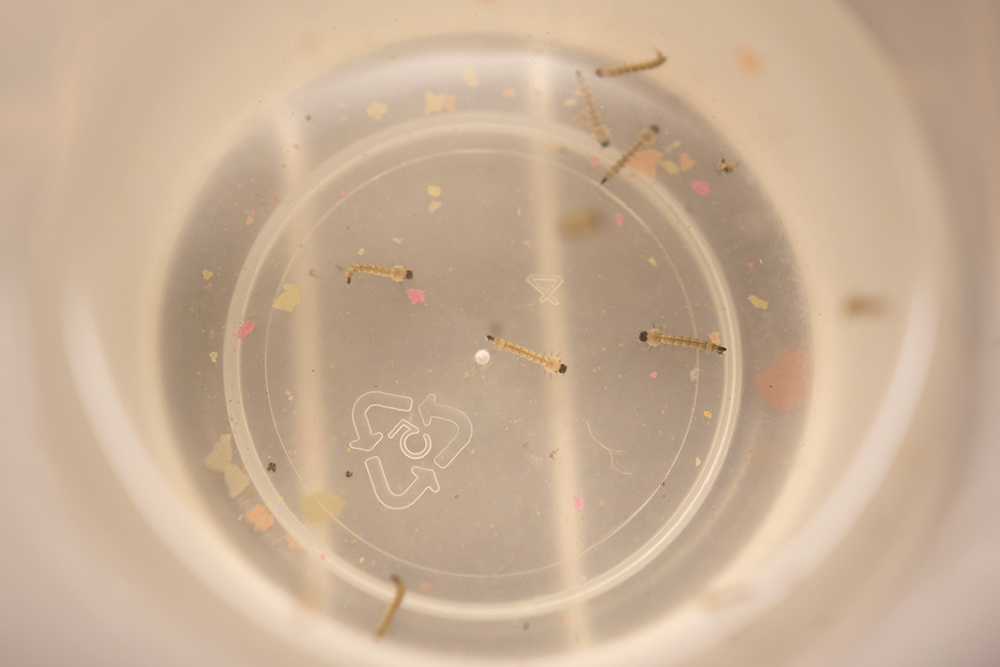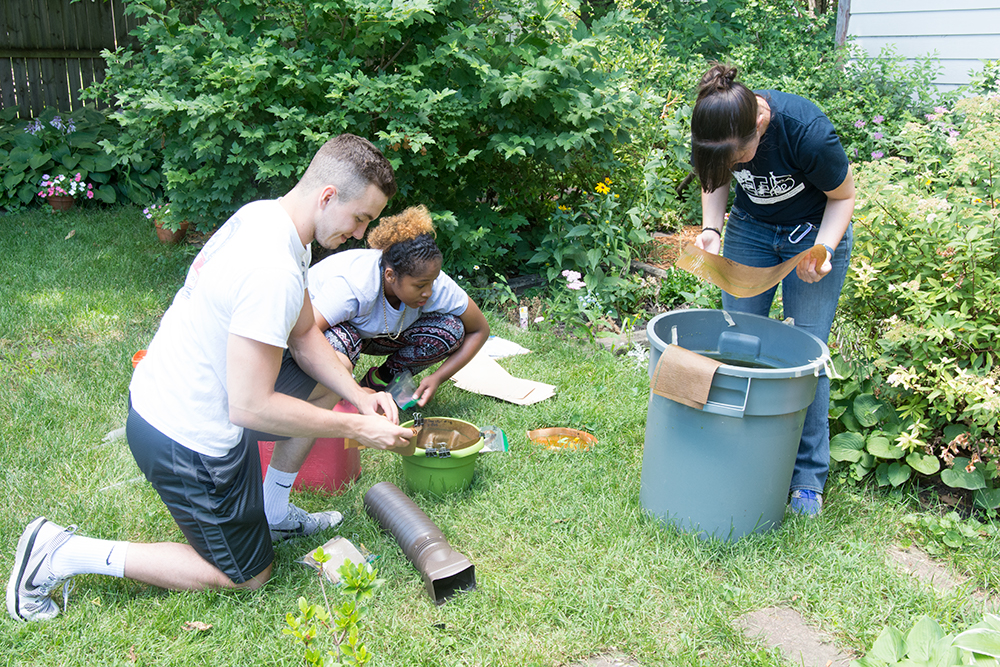Meet Allison Parker — Taking the Battle to the Mosquitoes

The saying goes that in war you must “know your enemy” to defeat it, and that’s exactly the aim of Allison Parker’s research. She’s a fifth-year Ph.D. Candidate in Entomology at the University of Illinois, and for more than half a decade, she’s been collecting, inventorying, and raising mosquito larvae to learn more about them so she can force their retreat from urban environments.
In most temperate and tropical areas of the world, mosquitoes pose a serious human health threat because of the diseases they transmit through bites. In a world growing more urban each day — and as the world climate warms extending mosquitoes’ livable range — a way to combat these pests in developed residential areas has become a grand world challenge. Pesticides are one option, but those chemicals have some negative environmental consequences. iSEE’s Stormwater and Mosquito Control team seeks less chemically reliant solutions.
Allison’s work focuses on the egg-laying stage of the mosquito lifecycle. Simply put: Intervening at that stage can reduce the number of babies that survive to become disease-spreading adults.
What makes a good mosquito nursery?
Mosquitoes start their lives as water-dwelling larvae, little worm-like creatures without wings or long legs. So, mother mosquitoes are searching for water. And not just any water; it needs to be stagnant water that’s been sitting around long enough for leave, sticks, and other debris to fall in, start decomposing, and become a microorganism buffet table for mosquito larvae.

Lots of seemingly harmless backyard items can turn into such sanctuaries after a rainfall. Are all created equal, or do mosquitos prefer one type of container over another? To find out, Allison reviewed her notes from past habitat studies and identified four of the most frequently occurring to test for mosquito preference: curbside trash cans, flowerpots, flowerpot drainage saucers, and corrugated plastic downspout extenders. Eight houses in residential neighborhoods of Champaign were given a set of these items to be placed outside and filled with a grass-infused water mixture to attract mosquitoes.
Every day, Allison and a few undergraduate research assistants visit all the test sites to gather the eggs and baby mosquitoes they find in each container type. In the middle of the summer months, it’s hot and sweaty work. They record the number and kind of specimens collected in each container at each house. These data will tell whether one type of container consistently outperforms another over an entire mosquito season.
Spending four to six hours a day in the field means there isn’t much lab time to process all the samples — counting mosquito eggs, hatching them, and then raising the larvae to identify the adult species. Luckily, Allison has the help of seven undergraduate students who work in shifts throughout the week to make sure that the lab work doesn’t lag behind.
“My favorite part of this research is working with the undergrads. They’re very enthusiastic, and we all share the fun and not-so-fun tasks,” she said.
Training and mentoring younger students actually inspired Allison to return to school for an advanced degree.

After completing a Bachelor’s Degree in Biology from the University of Richmond, she served as a high school science teacher in Dallas through the Teach for America program. While she was there, the area experienced an outbreak of West Nile virus. Pulling from her undergraduate research experience, she taught students about mosquito life cycles, how they’re controlled, and self-protection from bites.
“I really enjoyed those lessons. I realized I could combine a lot of different interests into mosquito research: microbiology, ecology, toxicology, social sciences, or health care fields. You can have a diverse group of people all working on similar projects,” she said.
“That experience also reminded me that mosquitoes aren’t just a pest, they make people sick and kill people (through the diseases they spread). I thought it would be valuable research for that reason to figure out new and better mosquito control. All of my research now is geared toward how we control mosquitoes in real neighborhoods.”
On its own, Allison’s research has a narrow scope: a handful of species in a single city in containers 1, 2, 3 or 4. However, combined with all her teammates’ work, she thinks that her work is contributing to an overall shift in how Champaign and other cities may create mosquito control programs.
“We’re all looking at different control measures,” she said. “Andrew Mackay looks at rain barrels and rain gardens and green infrastructure. (Former student) Allison Gardner’s work examined the catch basins for rainwater underneath streets. And my work is exploring various man-made containers in neighborhoods.”
“We’re all tackling the problem in our own little way, but taken together our results can make really good recommendations for control measures for city- and resident-implemented mosquito control programs.”
— Article by Olivia Harris, iSEE Communications Specialist